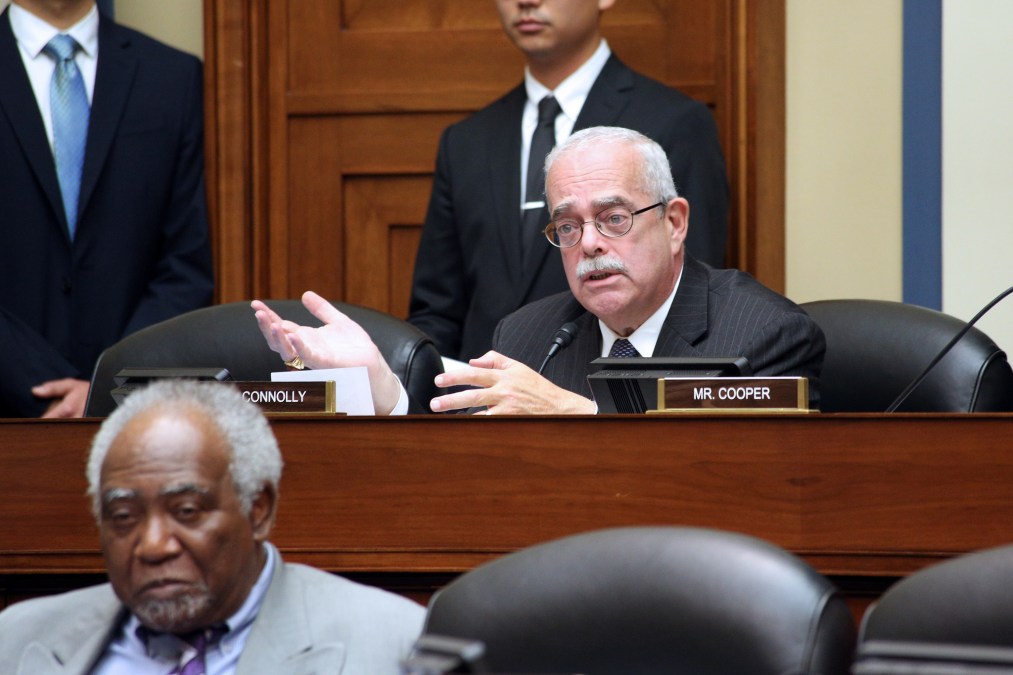PSNI accused of acting like Stasi after documents reveal eight ‘troublemaker’ journalists were under surveillance
‘The industrial-scale harvesting of sensitive journalistic comms data by the PSNI is akin to East German secret police in the early 1980s,’ Trevor Birney’s solicitor said.

Journalists Barry McCaffrey (left) and Trevor Birney (right) speaking to media after leaving the Royal Courts of Justice, in London, following an Investigatory Powers Tribunal (IPT) hearing over claims they were secretly monitored by police, on Tuesday May 7, 2024
Allison Morris
Eight journalists based in Northern Ireland considered “troublemakers” were under routine surveillance by the PSNI, according to documents released as part of a high-profile case being heard in London this week.
The Investigatory Powers Tribunal (IPT), sitting in the Royal Court of Justice, heard that the PSNI was engaging in six-monthly trawls of journalists’ phone data.
The IPT is examining allegations that two investigative reporters in Northern Ireland were subject to unlawful covert intelligence by the police as part of Operation Yurta.
Evidence presented to the tribunal today suggested that the PSNI spying operation extended to several other reporters operating in Northern Ireland.
The documents show the surveillance started in 2007/8 and went on for a decade, involving a small group of journalists who were, in the words of one detective, “always looking for a story”.
Documents seen by the Belfast Telegraph show eight redacted names of those under surveillance by the PSNI.
Documentary makers Barry McCaffrey and Trevor Birney were controversially arrested in 2018 by police investigating the alleged leaking of confidential documents that appeared in a film they made about the Loughinisland Massacre.
The PSNI was later forced to apologise and agreed to pay £875,000 in damages to the journalists and the film company behind the documentary No Stone Unturned.
In 2019, Mr Birney and Mr McCaffrey lodged a complaint with the IPT asking it to establish whether there had been any unlawful surveillance of them.
The PSNI had asked Durham Constabulary to take the lead in the investigation into the leaked Police Ombudsman document that appeared in the documentary on the 1994 loyalist paramilitary gun attack.
Last week it was revealed that journalist Vincent Kearney was also under surveillance during his time at the BBC.
The BBC has now instructed lawyers to contact the tribunal over claims one of its ex-investigative reporters, now working as RTE’s Northern Editor, was spied on by police.
New evidence released to the tribunal included a Durham Constabulary minute of a meeting between the senior investigating officer Darren Ellis, and two PSNI detective sergeants working in intelligence operations.
Ben Jaffey KC, representing Mr McCaffrey, revealed that the note made reference to what was described as a PSNI “defensive operation” against journalists in the region.
“It appears to disclose the existence of what the PSNI call a defensive operation involving the cross-referencing of billing with police telephone numbers on a six-monthly basis of what appears to be a group of Northern Irish journalists who have written unobliging things about the PSNI," he told the tribunal.
Mr Jaffey said the PSNI had yet to offer a response to the material disclosed by Durham Constabulary.
“But if this is what has been going on, we obviously say it's unlawful to go and take a list of troublemaker journalists, get their billing every six months and cross-reference it with a list of police telephone numbers, and see if those journalists have got any new police sources is plainly unlawful.
“A defensive operation can only be what we say is a slightly Orwellian euphemism.”
Mr Jaffey said the fresh evidence disclosed to the tribunal suggested Mr McCaffrey could have been subjected to many more covert spying bids.
“I think I made a cheap joke last time around that I'd lost count of the number of times that Mr McCaffrey has had his communications data obtained,” he said.
“That's no longer really, unfortunately, a joke.”
The barrister said the documents also raised a series of other incidents of concern, including:An attempt by police to access data from Mr Birney's wife,
A police consideration of accessing his solicitor Niall Murphy's personal data; and
A bid to secure international intelligence on Mr McCaffrey in relation to a trip he and Mr Birney had taken to France in 2016.
Mr Birney said the hearing made clear that the PSNI was “absolutely obsessed with journalists and their sources”.
“And I think we need to remind the PSNI and remind the authorities back in Belfast that journalism isn't a crime, that journalists all over the world have sources and that is lawful and that is absolutely what journalists are there to do,” he added.
His solicitor Niall Murphy said: “The revelations exposed in court are chilling. The industrial-scale harvesting of sensitive journalistic comms data by the PSNI is akin to East German secret police in the early 1980s.
"I fear that this is the thin edge of a wedge and that in time, a Kafkaesque systemic policy of police surveillance of journalists and lawyers will be exposed.”
Following the hearing, Mr McCaffrey said the PSNI had been practising the “dark arts”.
“The dark arts were supposed to be gone after the Good Friday Agreement, it seems that they're still here and they're thriving and they seem to be in charge, that can't be allowed to go on.”
His solicitor John Finucane added: “Durham police have provided the legal teams with disclosure which points to PSNI undertaking routine and industrial-scale surveillance on a six monthly basis against those journalists they criticised as “always looking a story”.
“The PSNI stands accused of unlawfully going after journalists and their sources on numerous occasions over a prolonged period.
"They also stand accused of lacking candour in how they have met these proceedings and that includes the potential compromising of Chief Constable John Boutcher, whose previous public statement on the scale of surveillance on journalists has been undermined by the disclosure we have received.
“Journalism is not a crime despite the actions and intent of PSNI, Durham and the MET,” he added.
The PSNI has been asked for a comment.
National Union of Journalists (NUJ) spokesman Ian McGuinness said: “Journalists exist to hold power to account and that includes writing stories about the PSNI which that force may not like.
“Writing a story about the PSNI and protecting your confidential sources whilst doing so is not a crime.
"The NUJ is calling, yet again, for the PSNI to come clean. In particular, the force needs to state when it started spying on multiple journalists’ phone data, who the journalists were, and how many times each journalist was spied upon and must give a commitment that it will desist from doing this ever again, simply to uncover legitimate sources for stories.”

Barry McCaffrey (L) and Trevor Birney (R) outside London's High Court on 8 May
Police in Northern Ireland may have regularly checked the phone records of multiple journalists in an attempt to uncover their sources, a London tribunal investigating the alleged surveillance of journalists has heard. Reporters Without Borders (RSF) calls on police to cooperate fully with the long-overdue tribunal, and account for any breaches of journalists’ vital right to protect their sources.
The UK’s Investigatory Powers Tribunal (IPT) - a body which hears complaints about surveillance by public bodies - is investigating the treatment by police of two journalists from Northern Ireland, Trevor Birney and Barry McCaffrey, who were arrested in 2018 on suspicion of stealing police documents - arrests that were later ruled unlawful by Northern Ireland’s High Court.
At a hearing on Wednesday 8 May attended by RSF, McCaffrey’s lawyer Ben Jaffey KC said that last week he received 600 new pages of evidence which threw up yet more questions about Police Service Northern Ireland (PSNI)’s covert surveillance. One document mentioned “defensive operations”, apparently in place at the end of 2017, against a small group of local journalists which involved “cross-referencing billing with police telephone numbers on a six-monthly basis”. Eight names - redacted in the document shown in court - were listed.
Calling for a full explanation of the new allegations, Jaffey also pointed to a request to access data from Birney’s wife, a request to secure intelligence on a trip Birney and McCaffrey had taken to France, and inconsistencies between the dates when data was obtained and the dates authorisations for that data collection were issued.
Next month will mark five years since Barry McCaffrey and Trevor Birney lodged a complaint with the Investigatory Powers Tribunal yet they are still waiting for clear answers about what appear to be deeply shocking breaches of their rights as journalists. The right of reporters to protect their sources is fundamental to public interest journalism, and if police have acted unlawfully, the public has a right to know. The PSNI must stop dragging its feet and fully cooperate with the tribunal, so that any serious violations of press freedom in Northern Ireland come to light.
Fiona O'Brien
Bureau Director, RSF UK
Three UK police forces - Durham Constabulary, PSNI and the Metropolitan Police - are implicated in the IPT’s investigation. Lawyers for Birney and McCaffrey have repeatedly complained about delays in the production of evidence, in particular from PSNI. Birney said what had emerged at the tribunal was revealing of the underlying attitude of police to journalists.
“It’s shocking that journalists going about their business lawfully were treated by the PSNI so unprofessionally,” he said after the hearing. “Ultimately, I think it’s an undermining of freedom of the press in Northern Ireland, an undermining of the relationship between the PSNI and journalists. Why did the police think this was acceptable?”
Last week, lawyers for the BBC said they had also contacted the tribunal over claims the PSNI had also tried to identify the sources of a former BBC reporter, Vincent Kearney, when he worked on a programme about the Police Ombudsman’s Office in 2011.
Wednesday’s hearing of the secretive tribunal was only the second to be held in public. The substantive hearing is scheduled to begin in October.
The UK is ranked 23rd out of 180 countries in RSF’s 2023 World Press Freedom Index. Northern Ireland is one of the most difficult regions for journalists to operate.












